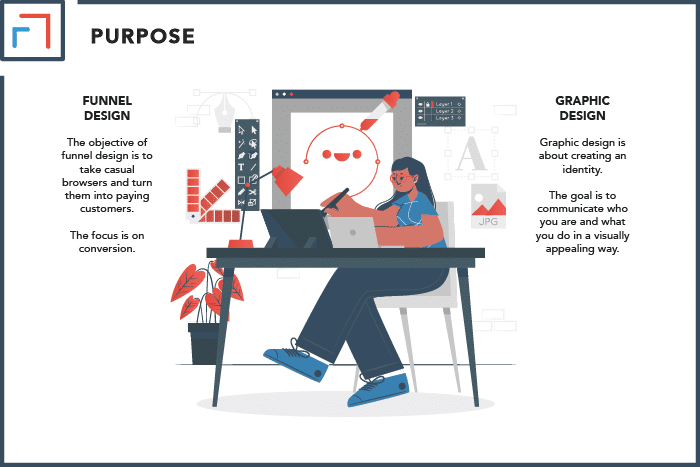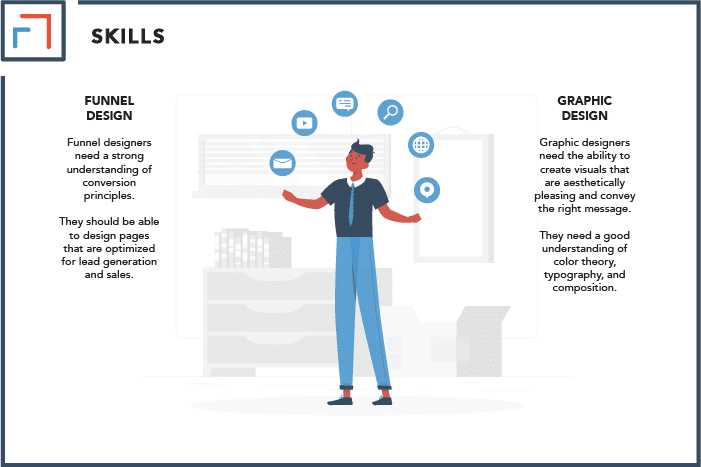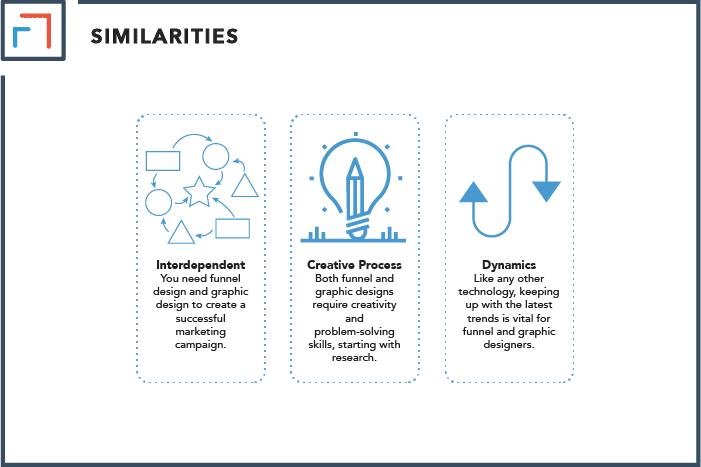Good design is essential for visual communication. Unfortunately, there is a lot of confusion about the difference between funnel and graphic designs. Some people think that they are the same thing. However, there are some distinct differences between the two.
When it comes to funnel design vs. graphic design, the former is about conversion, and the latter deals with brand identity. A funnel’s goal is to take a potential customer through steps that will eventually lead to a sale. The goal of graphic design is centered on branding and communication.
Funnel design and graphic design have some similar principles and can work hand in hand, but they are not the same thing. That said, let’s explore the similarities and differences between funnel and graphic designs.
Differences: Funnel Vs. Graphic Design
| Point Of Difference | Funnel Design | Graphic Design |
|---|---|---|
| Purpose | Sales conversions | Brand awareness |
| Target Audience | Potential leads | General population (not overly specific) |
| Tone | Direct & persuasive | Appealing |
| Function | Designing converting pages & funnels | Creating brand identity |
| Process | Top-down design | Down-top design |
| Skills | Conversion skills like understanding the buyer’s journey | Visual skills like color theory & brand promotion |
| Tools | Analytics tools | Visuals design tools |
| Results | Easily quantifiable | Difficult to quantify |
| Popularity & Application | Gaining in popularity | Consistently popular |
1. Purpose
The objective of funnel design is to take casual browsers and turn them into paying customers. The focus is on conversion.
Every element of the funnel is designed with the sole purpose of guiding the user towards a sale. Graphic design, on the other hand, is about creating an identity.
The goal is to communicate who you are and what you do in a visually appealing way. Graphic design is often used to create logos, websites, and marketing materials.

2. Target Audience
The target audience for funnel design is people that are interested in your product or service but haven’t made a purchase yet.
The goal is to convince them that your offer is the best solution to their problem. Graphic design has a broader target audience.
The aim is to create an identity that resonates with your target market. You don’t focus only on sales but on building relationships.
The goal is to create a visual language that your target audience can connect with.
3. Tone
Have you ever heard the phrase, “You never get a second chance to make a first impression?” First impressions are critical, especially when it comes to business.
That’s why it’s essential to understand the tone that appeals to your audience. The tone of the funnel design is very direct. The goal is to get the user to take action.
Therefore, the language is often persuasive. You want to make it easy for users to understand what you’re offering and why they need it.
Graphic design is more about building trust. The primary objective is to create a visual identity that will help your target market remember and recognize your brand.
You want to use colors, shapes, and fonts that convey the right message about your company.
4. Function
Although both funnels and graphics require designing, you focus on different things as you work on them.
Funnel design deals with the creation of product pages, lead capture forms, webinars, and other types of conversion-focused pages.
Graphic design, on the other hand, is about creating visuals for your brand identity, such as logos, websites, social media posts, and marketing materials.
The goal is to create a consistent look and feel for your brand.
5. Process
People say that good design is all about the details. While that’s true, the process of designing a funnel is very different from the process of creating a graphic.
When creating a funnel, you start with the big picture and then drill down to the details.
You need to have a clear understanding of the user’s journey before you can start designing each page. The process of creating a graphic is usually the opposite.
You can start with the details and then build up to the big picture. The goal is to create an identity that is consistent across all touchpoints.
6. Skills
I have seen designers trying to transition from graphic design to funnel design, and while it is possible, it’s not easy.
The skills required for each type of work are quite different.
Graphic designers need the ability to create visuals that are both aesthetically pleasing and convey the right message.
They need a good understanding of color theory, typography, and composition. Funnel designers need a strong understanding of conversion principles.
They should be able to design pages that are optimized for lead generation and sales. They should also know the user’s journey and design each page accordingly.

7. Tools
The tools you use for funnel design are different from those you use for graphic design.
Funnel design requires tools that help you track conversions and analyze user behavior.
You need to split-test different funnel elements to see what works and what doesn’t.
Graphic design requires tools that allow you to create visuals. This includes software like Photoshop, Illustrator, and InDesign.
8. Results
The results you achieve with funnel design are quantifiable. You can track the number of leads generated, sales made, and the conversion rate.
It’s essential to measure the results of your funnel so you can make improvements.
Graphic design is more about creating an emotional connection with your target market. The goal is to build trust and loyalty.
It’s challenging to quantify graphic design results, but you can measure brand awareness and customer satisfaction.
9. Popularity & Application
When I first started creating sales funnels, I thought funnel design was more popular because it seemed like there were lots of resources and training available.
But after working in the industry for a while, I realized that more businesses know about graphics than funnels.
While both types of design are important, graphic design is easier to see and appreciate. It’s the face of your brand.
Most business owners understand the application and value of graphic design, but funnel design is still in the growth stage.
As more businesses realize the importance of conversion-focused pages, the popularity of funnel design will grow.
Similarities Between Funnel & Graphic Designs
Now that we’ve explored the differences between funnel design and graphic design, let’s look at some of the similarities.
1. Interdependent
The most important similarity between these two forms of design is that they are interdependent. A well-designed funnel won’t convert if it doesn’t have strong visuals.
Similarly, a visually appealing brand won’t make sales if it doesn’t have a solid funnel to back it up.
You need funnel design and graphic design to create a successful marketing campaign.
They both play an essential role in the customer journey, and they can work together to achieve amazing results.
2. Creative Process
The creative process for both funnel design and graphic design starts with research. You need to understand your target market and what they’re looking for.
Once you know your audience well, you can start creating your designs. Both funnel and graphic designs require creativity and problem-solving skills.
You need to think outside the box to create designs that stand out from the competition.
3. Dynamics
Like any other technology, keeping up with the latest trends is vital for funnel and graphic designers.
The design industry is constantly evolving, and new tools and trends are always emerging. Apart from that, there is no one-fits-all solution for design.
The needs of each business are different, so the designs you create will be unique to your brand.

The Bottom Line
Both funnel design and graphic design are important for businesses. They play different but essential roles in the customer journey.
If you want to create a successful marketing campaign, you need both. But which one should you focus on first? Well, it depends on your business goals.
If you’re looking to generate leads and make sales, funnel design should be your priority.
But if you’re trying to build trust and loyalty with your target market, graphic design should be your focus. However, don’t neglect one to focus on the other entirely.
Invest in funnel and graphic designs to create a well-rounded marketing campaign.
